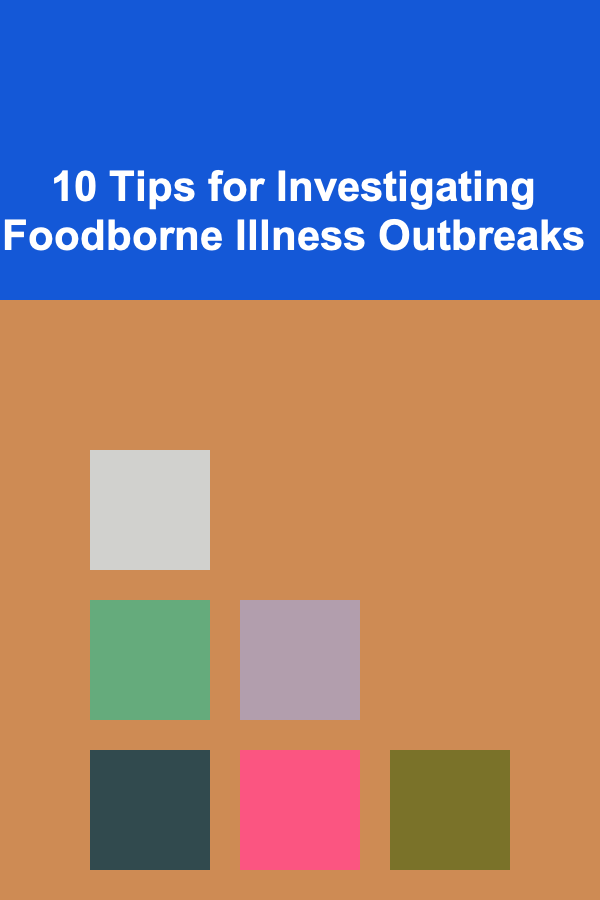
10 Tips for Investigating Foodborne Illness Outbreaks
ebook include PDF & Audio bundle (Micro Guide)
$12.99$5.99
Limited Time Offer! Order within the next:

Foodborne illness outbreaks are a serious public health concern that can have significant impacts on individuals, communities, and the broader food industry. When outbreaks occur, prompt and effective investigation is crucial to identify the source of the illness, control its spread, and prevent future occurrences. Investigating foodborne illness outbreaks requires a systematic approach, collaboration among various stakeholders, and the use of both scientific techniques and effective communication strategies.
In this article, we'll explore 10 essential tips for investigating foodborne illness outbreaks. These tips are designed to guide investigators through the process of identifying the source of the outbreak, understanding its spread, and implementing measures to protect public health.
Gather Detailed Information from Affected Individuals
The first step in investigating a foodborne illness outbreak is to collect as much information as possible from the individuals who have been affected. This includes conducting interviews with patients or their family members to gather data about their symptoms, the foods they consumed, and any other factors that might help identify the source of the illness.
Key information to gather includes:
- Symptoms: What symptoms did individuals experience, and when did they appear? Common foodborne illness symptoms include nausea, vomiting, diarrhea, abdominal cramps, and fever. Understanding the timeline and severity of symptoms helps in narrowing down potential pathogens.
- Food History: Investigate what foods the affected individuals consumed in the days leading up to the onset of symptoms. Pay close attention to foods that are typically associated with foodborne illness, such as raw or undercooked meat, dairy products, eggs, and fresh produce.
- Exposure Locations: Inquire about where the affected individuals ate, including restaurants, homes, and other public places. This will help identify any shared sources of contamination.
- Incubation Period: Understanding the time between exposure to the pathogen and the appearance of symptoms (incubation period) can help determine which pathogen is responsible. For example, norovirus typically has an incubation period of 12-48 hours, while Salmonella can take 6-72 hours.
Review Health Records and Laboratory Results
Once you have gathered detailed information from affected individuals, it's essential to review health records and laboratory results to confirm the diagnosis and identify the pathogen responsible for the outbreak. Laboratory testing plays a critical role in determining the specific pathogen and distinguishing between different types of foodborne illnesses.
- Microbiological Testing: Laboratory tests, such as stool cultures, blood tests, and PCR (Polymerase Chain Reaction) testing, are used to identify the presence of pathogens like Salmonella, E. coli, Listeria, or Campylobacter. Testing samples from affected individuals can provide concrete evidence linking the outbreak to a specific pathogen.
- Epidemiological Data: Epidemiological studies, including case-control studies, can help investigators identify risk factors associated with the outbreak. Comparing the food histories of affected and unaffected individuals can point to specific foods or food items that were more likely to cause illness.
- Environmental Testing: Samples from food establishments, processing facilities, or food products may also be tested to identify contamination. These samples help link the illness to a specific source.
Conduct an Epidemiological Investigation
Epidemiological investigations are key to understanding the scope and spread of the outbreak. The goal is to identify patterns of illness and track the source of contamination by analyzing data on affected individuals and their exposure to food items.
- Define the Case: Establish a clear definition of what constitutes a case in the context of the outbreak. This includes specific symptoms, laboratory findings, and the timeframe of illness onset. A well-defined case definition ensures that all affected individuals are correctly identified.
- Collect Data on Exposures: Once the cases have been defined, gather information about potential food exposures. This can include detailed food history questionnaires, food consumption logs, or surveys of affected individuals. The more data you can collect, the easier it will be to trace the outbreak's origin.
- Statistical Analysis: Use statistical tools to analyze the data and identify patterns. For example, you may find that individuals who ate a certain food item are more likely to become ill. These statistical findings help pinpoint the likely source of the outbreak.
Identify and Interview Key Stakeholders
In addition to speaking with affected individuals, it is essential to interview key stakeholders in the food production, processing, and distribution chain. This can include food suppliers, restaurant owners, food safety inspectors, and local health authorities. Their insights can provide important context and help identify potential sources of contamination.
Key stakeholders to interview include:
- Food Suppliers: Suppliers of raw ingredients may be able to provide information about the source of the food, including the farms or processing plants where the food was grown or processed.
- Food Establishments: Restaurants, grocery stores, or catering services involved in the outbreak should be interviewed to determine whether there were any lapses in food safety practices. This may include improper handling, cooking, or storage of food items.
- Local Health Departments: Public health authorities can provide epidemiological support and help trace cases, as well as identify patterns in reported illnesses across the region.
Track the Spread of the Outbreak
Once the initial source of the outbreak has been identified, it's crucial to track the spread of the illness. Foodborne illnesses can spread quickly, especially when contaminated food is distributed widely across multiple locations or regions. Tracking the spread helps identify how the illness moved from one group to another and informs control measures.
To track the spread, consider the following:
- Geographical Mapping: Use geographic information systems (GIS) to map out where affected individuals live, work, and ate. This will help identify hotspots where the outbreak may have spread more quickly.
- Time Sequence: Analyze the timeline of the outbreak to determine when and where the illness likely began. This helps identify the initial point of contamination and how long it took for cases to surface in different areas.
- Spread Patterns: Investigate whether the outbreak spread to specific areas or was contained to a specific group of individuals (e.g., a restaurant, a school, or a family gathering). Understanding how the illness spread is essential for effective containment.
Implement Control Measures and Public Health Interventions
Once the outbreak's source and spread have been identified, the next step is to implement control measures to stop the illness from spreading further. These interventions may include:
- Recalls and Withdrawals: If the source of the contamination is traced to a specific food item, a recall or withdrawal should be issued to remove the contaminated products from the market or food establishments.
- Inspection and Enforcement: Health inspectors may need to visit food establishments or processing plants to ensure that food safety protocols are being followed. Any lapses in food safety practices should be corrected immediately.
- Public Health Advisories: Public health authorities may issue advisories or warnings to alert the public about the outbreak and provide recommendations on what to do if they've been exposed. This can include guidance on what foods to avoid or steps to take if symptoms develop.
- Isolation of Affected Areas: In some cases, it may be necessary to temporarily close restaurants, markets, or other establishments to prevent further exposure. Additionally, restricting the movement of contaminated food may be necessary to limit the spread.
Collaborate with Federal and State Agencies
Foodborne illness outbreaks often require collaboration between local, state, and federal agencies. These agencies bring additional expertise, resources, and authority to the investigation. Federal agencies like the Centers for Disease Control and Prevention (CDC), the Food and Drug Administration (FDA), and the United States Department of Agriculture (USDA) play important roles in outbreak investigations.
Collaboration can involve:
- Sharing Data: Local health departments and federal agencies can share epidemiological data, laboratory results, and other findings to track the outbreak and identify its source.
- Coordinating Resources: Federal agencies can provide additional resources, such as personnel, laboratory facilities, or funding, to support the investigation and response.
- National or Regional Alerts: Federal agencies may issue nationwide or regional alerts to inform the public, businesses, and other stakeholders about the outbreak and the actions they should take.
Review and Improve Food Safety Protocols
Investigating foodborne illness outbreaks also provides an opportunity to review and improve food safety protocols. Once the outbreak is controlled, it's important to assess the effectiveness of food safety practices and identify areas for improvement.
Some steps to take include:
- Evaluate Existing Procedures: Review the current food safety protocols used by food establishments, manufacturers, and suppliers involved in the outbreak. Were there lapses or areas where food safety practices could be improved?
- Update Guidelines: If necessary, update food safety guidelines to reflect the lessons learned from the outbreak. This could involve revising procedures for handling food, cooking temperatures, storage, and sanitation practices.
- Training and Education: Offer training to food handlers and other relevant personnel to reinforce best practices in food safety. This can include educating workers about proper hygiene, temperature control, and preventing cross-contamination.
Conduct Post-Outbreak Surveillance
Once the outbreak is under control, post-outbreak surveillance is essential to ensure that no new cases are emerging. Continued monitoring helps identify any lingering issues that could lead to further outbreaks and allows for rapid response if necessary.
Post-outbreak surveillance includes:
- Ongoing Case Reporting: Encourage healthcare providers to report new cases of foodborne illness to public health authorities. This allows for quick detection of any emerging cases related to the outbreak.
- Long-Term Monitoring: Track trends in foodborne illness rates over time to identify any patterns or increases in cases that may require further investigation.
- Follow-up on Recalls: Ensure that all recalled products have been removed from the market and that affected individuals receive proper treatment and support.
Communicate Transparently with the Public
Effective communication with the public is a critical component of any foodborne illness outbreak investigation. Clear, transparent, and timely communication helps reduce panic, prevent the spread of misinformation, and ensure that the public follows the necessary precautions.
Key communication strategies include:
- Regular Updates: Provide regular updates to the public through news outlets, social media, and official websites. Keeping the public informed about the outbreak, its source, and the steps being taken to control it helps build trust.
- Clarify Actionable Steps: Make sure that the public knows what steps to take if they suspect they've been affected. This may include seeking medical attention, reporting symptoms, or avoiding certain foods.
- Encourage Reporting: Encourage individuals to report any suspected foodborne illness to public health authorities, as this information can help trace the source of the outbreak and prevent further cases.
Investigating foodborne illness outbreaks requires a comprehensive, multi-faceted approach that involves gathering data, analyzing patterns, collaborating with stakeholders, and implementing control measures. By following these 10 essential tips, public health authorities and investigators can respond effectively to outbreaks, mitigate their impact, and ultimately protect public health.
Reading More From Our Other Websites
- [Needle Felting Tip 101] How to Produce Ultra‑Fine Needle Felted Textures for Realistic Human Skin in Miniature Sculptures
- [Home Budget 101] How to Negotiate Better Deals for Home Services and Repairs
- [Organization Tip 101] How to Use Baskets for Organizing Hair Accessories
- [Organization Tip 101] How to Keep Track of Local Rental Laws and Regulations
- [Organization Tip 101] How to Create a Stylish Shoe Display in Your Entryway
- [Home Storage Solution 101] How to Create a Small Closet Storage Solution with DIY Projects
- [Home Staging 101] How to Stage Your Home's Outdoor Space for Entertainment
- [Sewing Tip 101] Mastering the Art of Hand-Sewing Buttons: A Step‑Step Guide
- [Organization Tip 101] How to Use Trunks and Chests for Stylish Storage
- [Home Budget 101] How to Budget for a Family of Four

How to Choose the Right Holiday Colors for Your Home Decor
Read More
How to Compare Dropshipping Suppliers to Choose the Best Fit for Your Business
Read More
How to Design Eye-Catching Digital Ads for Maximum Engagement
Read More
How to Maintain an Organized Kitchen Countertop
Read More
How to Use Calendar Apps for Better Time Management
Read More
10 Tips for Staying Inspired as a UX Designer
Read MoreOther Products

How to Choose the Right Holiday Colors for Your Home Decor
Read More
How to Compare Dropshipping Suppliers to Choose the Best Fit for Your Business
Read More
How to Design Eye-Catching Digital Ads for Maximum Engagement
Read More
How to Maintain an Organized Kitchen Countertop
Read More
How to Use Calendar Apps for Better Time Management
Read More